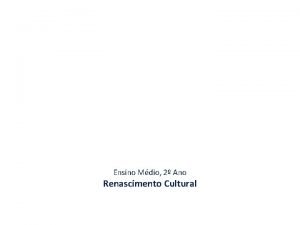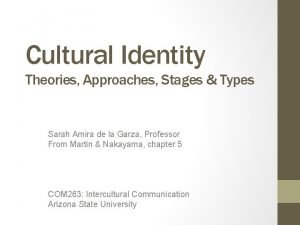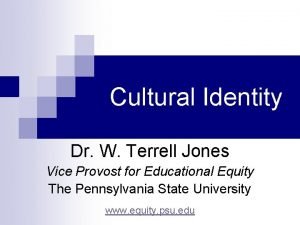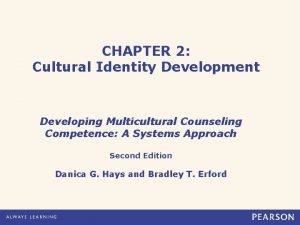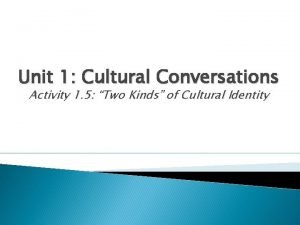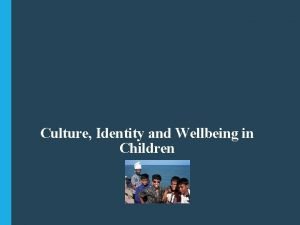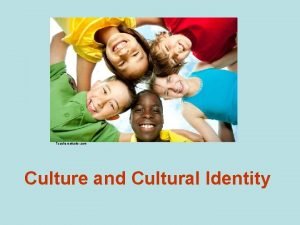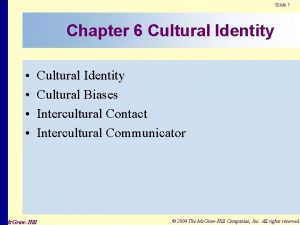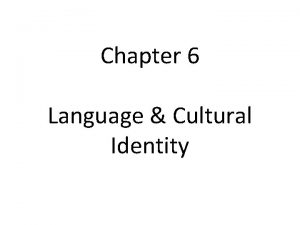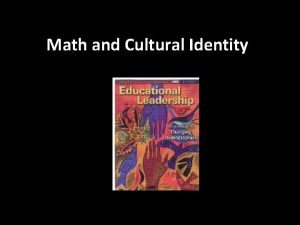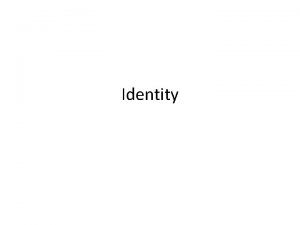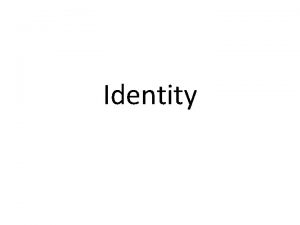Slide 1 Chapter 6 Cultural Identity Cultural Identity














- Slides: 14

Slide 1 Chapter 6 Cultural Identity • • Cultural Identity Cultural Biases Intercultural Contact Intercultural Communicator Mc. Graw-Hill © 2004 The Mc. Graw-Hill Companies, Inc. All rights reserved.

Slide 2 Cultural Identity • Nature of Identity – Cultural identity: belonging to a particular culture or ethnic group ØEthnic Identity: generally defined on the basis of cultural criteria (customs, language) ØRacial Identity: generally defined on the basis of physical criteria (skin color, facial features) Mc. Graw-Hill © 2004 The Mc. Graw-Hill Companies, Inc. All rights reserved.

Slide 3 Identity Social Identity: Memberships that are particular to cultural identity Personal Identity: Activities that differ from cultural identity; Sexuality; individuality Mc. Graw-Hill © 2004 The Mc. Graw-Hill Companies, Inc. All rights reserved.

Slide 4 Identity Ø Gender identity Ø Pink or Blue? Ø Nature or Nurture? Ø Brain Research: Color, texture, motion, Language Ø Age Identity Ø Infant/Child Ø Adolescent Ø Adult Ø Middle Age Ø Senior Citizen Ø Mixed Identity Mc. Graw-Hill © 2004 The Mc. Graw-Hill Companies, Inc. All rights reserved.

Slide 5 Identity • Religious identity • Socioeconomic Identity • National/Regional Identity Mc. Graw-Hill © 2004 The Mc. Graw-Hill Companies, Inc. All rights reserved.

Slide 6 Identity Development • Unexamined Cultural Identity • Cultural Identity Search • Cultural Identity Achievement Mc. Graw-Hill © 2004 The Mc. Graw-Hill Companies, Inc. All rights reserved.

Slide 7 White Privilege • Normative Race Privilege – Dominant culture – Individual Identity – Guilt for being white – Perceptions of Privilege – Loss of privilege – (reading) Mc. Graw-Hill © 2004 The Mc. Graw-Hill Companies, Inc. All rights reserved.

Slide 8 ØEthnocentrism Ø The tendency people have to evaluate others according to their own standards and experience Ø While this tendency can help bind people together, it can also present serious obstacles to cross-cultural interactions Mc. Graw-Hill (c) 2006 The Mc. Graw-Hill Companies, Inc. All rights reserved. Cushner/Mc. Clelland/Safford, Human Diversity in Education, 5/e © 2004 The Mc. Graw-Hill Companies, Inc. All rights reserved.

Slide 9 ØCategorization Ø Categorization is the cognitive process by which all human beings simplify their world by grouping similar stimuli Ø Our categories give meaning to our perceptions Mc. Graw-Hill Ø A prototype image best characterizes the meaning of a category Ø Example: for the category “bird, ” we usually think of robins, not chickens (c) 2006 The Mc. Graw-Hill Companies, Inc. All rights reserved. Cushner/Mc. Clelland/Safford, Human Diversity in Education, 5/e © 2004 The Mc. Graw-Hill Companies, Inc. All rights reserved.

Slide 10 ØStereotypes Ø Stereotypes are socially constructed categories of people Ø They usually obscure differences within groups Ø They are frequently negative and play to ethnocentric ideas of “the other” Mc. Graw-Hill (c) 2006 The Mc. Graw-Hill Companies, Inc. All rights reserved. Cushner/Mc. Clelland/Safford, Human Diversity in Education, 5/e © 2004 The Mc. Graw-Hill Companies, Inc. All rights reserved.

Slide 11 Understanding Prejudice and Racism Ø Ethnocentrism leads people to believe that their own “ways” are good and “natural” Ø Prejudice implies a lack of thought or care in making a judgment about others Ø While racial and ethnic prejudice can be expressed both positively and negatively, in the United States it is most often negative Mc. Graw-Hill (c) 2006 The Mc. Graw-Hill Companies, Inc. All rights reserved. Cushner/Mc. Clelland/Safford, Human Diversity in Education, 5/e © 2004 The Mc. Graw-Hill Companies, Inc. All rights reserved.

Slide 12 Racism, Cont’d • • • Symbolic Racism Tokenism Aversive Racism Likes & dislikes Degree of unfamiliarity Mc. Graw-Hill © 2004 The Mc. Graw-Hill Companies, Inc. All rights reserved.

Slide 13 Extreme Cases of Prejudice Ø Racism—the transformation of prejudicial attitudes through the use of power directed toward those one regards as inferior Ø Hate Groups—any organized body that denigrates select groups of people based on ethnicity, race, religion, or sexual orientation Ø White Privilege—the largely unconscious acceptance by dominant groups of privileges denied to oppressed groups Ø Racial Profiling—law enforcement practices aimed at those who “fit” a particular profile— usually age, ethnicity, and/or race Mc. Graw-Hill (c) 2006 The Mc. Graw-Hill Companies, Inc. All rights reserved. Cushner/Mc. Clelland/Safford, Human Diversity in Education, 5/e © 2004 The Mc. Graw-Hill Companies, Inc. All rights reserved.

Slide 14 Something to Think About “One of the higher callings for young people in the coming century will be working to increase intercultural understanding. Such people will be the missionaries of the age, spreading light among groups. . . by giving them a modern vision of the new global community. ” —Carl Coon Mc. Graw-Hill (c) 2006 The Mc. Graw-Hill Companies, Inc. All rights reserved. Cushner/Mc. Clelland/Safford, Human Diversity in Education, 5/e © 2004 The Mc. Graw-Hill Companies, Inc. All rights reserved.
 Heel toe polka music
Heel toe polka music Slide method factoring
Slide method factoring Social identity map
Social identity map Renascimento cultural
Renascimento cultural Imagens do renascimento cultural
Imagens do renascimento cultural Cultural identity development models
Cultural identity development models Cultural identity development models
Cultural identity development models Cultural identity search refers to the
Cultural identity search refers to the Cultural identity development models
Cultural identity development models Two kinds of cultural identity activity 1.5 answer key
Two kinds of cultural identity activity 1.5 answer key Cultural identity context clue
Cultural identity context clue Cultural identity
Cultural identity Why is culture identity important
Why is culture identity important Vocabulary activity 12 cultural geography of europe
Vocabulary activity 12 cultural geography of europe Cultural dynamics in assessing global markets
Cultural dynamics in assessing global markets




